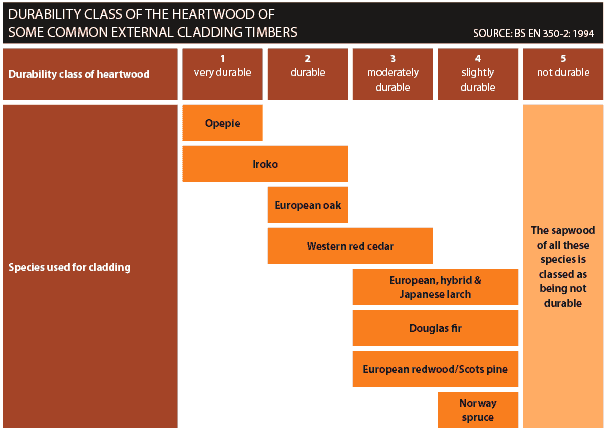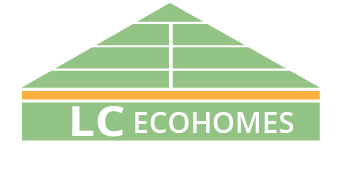Timber Species Durability
For External Cladding
When considering timber for external cladding purposes, probably the biggest single factor, is its durability. Other important follow on factors are of course, Price and Availability.
Many timber species are graded under BS EN 350-2, into five categories. The classifications quoted refer to the resistance to fungal decay of the heartwood of the species only. The sapwood of most species is not durable or slightly durable and should not be used in exposed situations without preservative treatment. Five natural durability to wood-destroying fungi classes are recognised in BS EN 350-1 Guide to the principles of testing and classification of the natural durability of wood.
Durability Classification:
The classifications in this sheet are those given in BS EN 350-1 for the timbers included.
Insect attack is generally of less significance in the UK. Information on the resistance of some timbers to insect and marine borer attack is given in BS EN 350-2 Guide to natural durability and treatability of selected wood species of importance in Europe.
Guidance on the need for preservative treatment in particular situations is given in BS 8417:2003. Note that BS 5268-5 and BS 5589 are now obsolete. These are shown, with a typical example of a timber species, in each. In the case of Western Red Cedar (WRC), where it is across two columns, if the timber is North American (generally always Canadian), then the timber is graded “Durable”. Imported Western Red Cedar is the only Softwood ranked within the “Durable” category. However, home grown WRC only achieves ‘Moderately Durable’ grading.
In the case of those other species spread over ‘Moderately’ and ‘Slightly’ durable, this depends on the quality of the timbers selected, with only the prime being ‘Moderately Durable’. In many instances, prime grade would be used for milled products as opposed to basic cladding.
We have attached below, the data sheets for the timber species listed within the TRADA database, suitable for ‘Cladding’. We generally also added the parameter, that they were “Readily available from timber merchants. We omitted this requirement within the ‘Very Durable’ category, and otherwise it returned a ‘none found’.
We have attached below, the data sheets for the timber species listed within the TRADA database, suitable for ‘Cladding’. We generally also added the parameter, that they were “Readily available from timber merchants. We omitted this requirement within the ‘Very Durable’ category, and otherwise it returned a ‘none found’.
| Species | Availability | Durability |
|---|---|---|
| Afzelia | Restricted | VD |
| Cumaru | Restricted | VD |
| Itauba | Restricted | VD |
| Western Red Cedar (Imported) | OK | D |
| Oak, Europea | OK | D |
| Western Red Cedar (Home Grown) | Restricted | MD |
| Douglas Fir | OK | MD / SD |
| Larch, European | OK | MD / SD |
| Pine, Scots | OK | SD |
| Redwood, European | OK | SD |
The natural durability of Western Red Cedar is not the only reason we have chosen, and recommended it’s use.
Other strong considerations, where it is superior to the other species are :-
- Looks great and smells wonderful.
- Resin free – it naturally does not occur so it does not ‘weep’
- Stable – WRC stays straight and is very resistant to warping
- Natural Insect Deterrent – the naturally occurring chemicals within the wood, resists attack from most woodboring insects.
- Lightweight
- Good thermal and acoustic insulator
- Accepts finishes well
If you any further questions about Western Red Cedar, then please contact us, and I’m sure we can assist.


